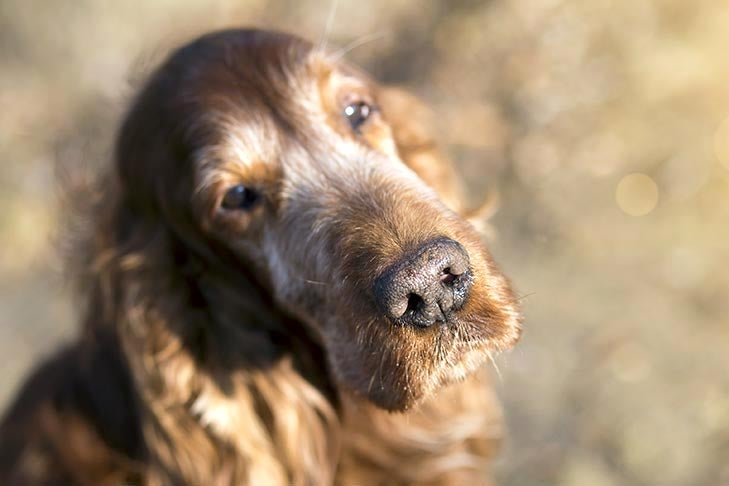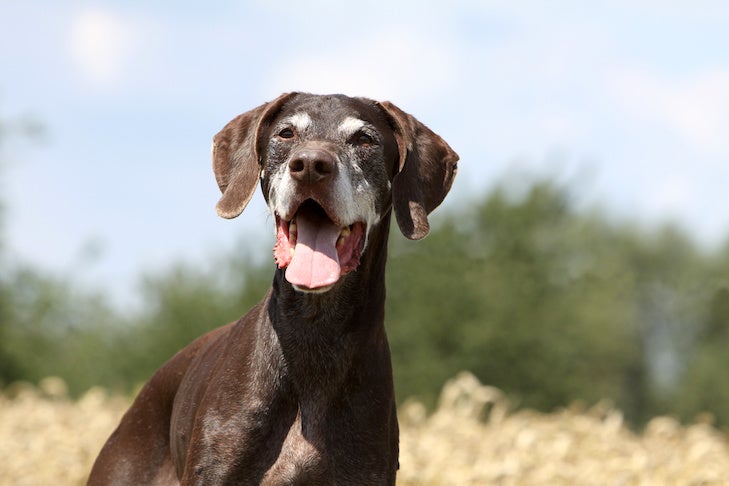AKC is a participant in affiliate advertising programs designed to provide a means for sites to earn advertising fees by advertising and linking to akc.org. If you purchase a product through this article, we may receive a portion of the sale.
Senior dogs have different nutritional needs as they age, and what they need also depends on the dog. Finding the right senior dog food can be difficult: the food that your dog has known and loved all their life may not be working for them anymore. Maybe they’re not as food-driven, or have dental problems that don’t allow them to chew dry food like they used to.
Finding the first senior dog food is also not as clear as other life stages in dogs. Neither the Association of American Feed Control Officials (AAFCO) nor the National Research Council have determined official dietary requirements for aging dogs. It’s partly because senior dogs vary so much in their individual needs. That may explain why commercial foods for seniors vary so widely in nutrient levels.
Nobody expects you to be a nutritionist just to pick out a bag of dog food. But you should be aware of just a few important factors that apply to most senior dogs.
Types of Senior Dog Food
There are practical aspects of feeding your dog to consider, too. Senior dogs may have dental problems that make chewing difficult or uncomfortable. Very old dogs also often lose their appetite. Warming the food can increase its aroma and may help stimulate the appetite, while cooling it may make it less nausea-inducing in dogs with sensitive stomachs or frequent nausea.
Dry Dog Food
Dry dog food is a common choice for dogs throughout their lives. But dry dog food for senior dogs isn’t always the right choice. Depending on the dog, it can be difficult for senior dogs to chew and swallow. Especially if they have dental issues, chewing kibble can be hard for older dogs. Even getting smaller-sized kibble can help them more easily enjoy dry food. Adding water to their food to soften it can also help make it easier for senior dogs.
Dry dog food has benefits that can extend to senior dogs. The solid corners help reduce plaque on your dog’s teeth and rub off tartar. It’s also easy to use as a treat to give your dog, since you can give them small pieces instead of treats if they’re food-driven.
Wet Dog Food
Dehydrated dogs and dogs with dental problems will benefit from wet senior dog food. It contains a lot of water, so if your dog isn’t drinking as much as they used to, it can help them get the water intake that they need. It’s easy to chew since it’s soft, so it’s a great food choice for senior dogs, or dogs that are missing teeth. Because it has a higher water content, wet dog food is also typically a lower-calorie choice than dry food.

Specialty Diets for Senior Dogs
If your dog has special dietary restrictions or has developed them as they’ve gotten older, there are options. Senior dog foods also come in specialty diets like grain-free, organic, weight management, gluten-free, or veterinary diet foods. If your dog has a food allergy or sensitivity, talk to your vet about the best type of food for your dog and what ingredients to avoid.
Senior dogs may be uncomfortable bending down to the food bowl or standing for long periods to eat. Try serving their meals on a raised platform or encourage them to eat lying down. In some senior dogs, their “hunger mechanism” and food drive may not be working correctly. If you’re having trouble getting your senior dog to eat, talk to your vet about options to help them eat so they get the nutrients that they need.
Dog Food for Common Health Issues in Senior Dogs
It’s important to consider senior dog health problems when choosing food for your dog. Senior dogs often have conditions like dog obesity, sensitive stomachs, canine arthritis, osteoarthritis, heart disease, and kidney disease. Some dog foods that are made for senior dogs have ingredients included that can help reduce inflammation, help maintain weight, and boost immune systems. Some senior dog foods also specifically work to help dog cognition, digestive health, joint health, mobility, and keeping their skin and coat healthy.
For heart and kidney disease, you’ll want a low-sodium food. But, the study found that sodium levels in senior foods ranged from 33 to 412 mg/100 kcal. For kidney disease, you’ll want low phosphorous, but it’s usually not even mentioned on any label. The study found phosphorous levels varied by threefold in the senior foods they examined, but were on average higher than their representative adult maintenance food.
Prescription diets are available for heart disease, kidney disease, and other diseases that take into account these nutritional needs. However, even those foods may have wide ranges of nutrients. Any dog food manufacturer should be able to provide these numbers to you on their website or with a simple phone call. While you’re at it, ask them about the credentials of the people formulating their foods. If they can’t provide either, that’s clue number one that you should find another product.

Don’t Restrict Protein
Many people still believe senior dogs should eat less protein, but that’s not the case. Healthy seniors need more protein, not less, in order to fuel muscle. Loss of muscle mass is a major problem in older dogs. Some seniors lose so much muscle they can no longer walk unassisted.
According to Veterinarian Ernie Ward, older dogs need about 50% more protein to maintain muscle mass compared to younger ones. But, diets formulated for adult maintenance diets often don’t have enough protein to satisfy these needs. Dr. Ward, founder of the Association for Pet Obesity Prevention, recommends 28 to 32% protein on a dry-matter basis for healthy older dogs, especially in those cases where weight loss is needed.
Consider Calories
Younger seniors tend to be overweight. But, very old dogs tend to be underweight. Calories in senior foods vary widely, ranging from 246 to 408 calories per cup. So the same senior food may be a great choice if your dog needs to lose weight, but it may be a bad choice if they need to gain weight.
Good care for senior dogs starts in youth. Don’t forget that the time to consider calories is well before old age sets in. Restricting calories throughout life can improve longevity and reduce illness.
Add Supplements
Some senior foods include supplements such as glucosamine and chondroitin in an effort to combat osteoarthritis. Unfortunately, the evidence that these supplements actually work is limited. However, they won’t hurt—except maybe your wallet.

On the other hand, omega-3 fatty acids probably play an important role in senior diets because they may help combat both osteoarthritis and especially cognitive losses. If you are adding your own to your dog’s diet, aim for the amount of EPA and DHA combined to be in the range of 700 to 1,500 mg. Build up starting at the low end and cut back if your dog has any diarrhea or vomiting.
Transitioning From Adult to Senior Dog Food
Your dog will be considered an “adult dog” for the majority of their life, which means they’ll be eating the same or similar food for the majority of their lives. Switching dog food gradually as their needs change is an important part of transitioning to senior dog food.
Without a smooth transition, your dog could face digestive issues, or you could uncover an allergy that you didn’t know your dog had. Doing this slowly allows you to monitor and detect changes in your dog’s behavior, appetite, and stool to make sure their food is giving them a boost to live a long, happy life.

